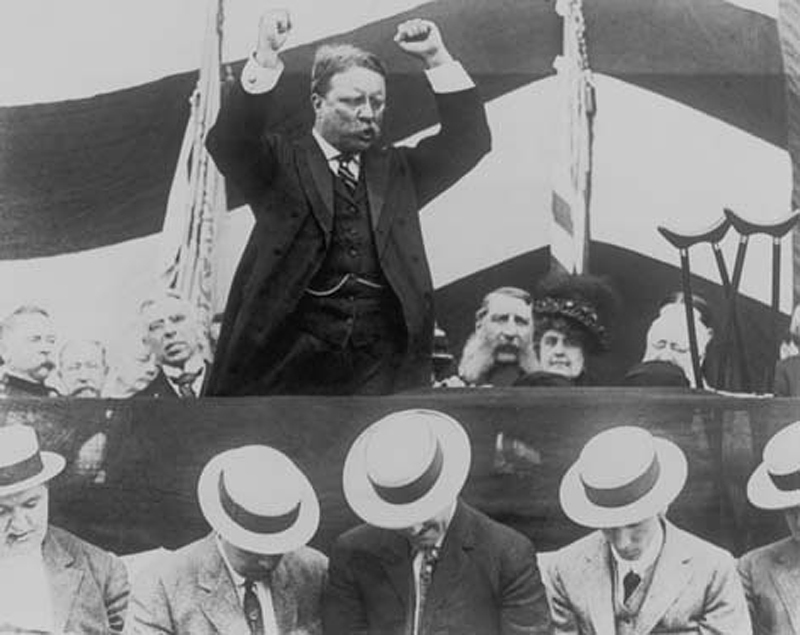
Craig A. Jones recently graduated with a PhD in Public Policy and Administration from Boise State’s School of Public Service. His research focuses on how presidents use rhetorical and administrative tools of presidential control to expand and reinforce executive power, primarily at the expense of Congressional deliberation. Craig works on energy and environmental policy in the southeast and has more than three decades of experience in the energy sector.

Teddy Roosevelt once confessed, “Most of us enjoy preaching, and I’ve got such a bully pulpit.” The term “bully pulpit” stuck, and as historian David Greenberg notes, has become synonymous with how presidents use the Executive Office to “seize the public imagination” and engage “mass media to mold public opinion.” Since ascending to the highest office in America, President Donald Trump has used his bully pulpit to great effect by promoting policies on immigration, international trade, foreign policy, and domestic markets, among many others.
But the president and his bully pulpit are especially conspicuous in today’s coronavirus crisis. Using the bully pulpit of his daily press briefings and Twitter account, President Trump has rhetorically set the national agenda and directed America’s response to a pandemic that is testing the limits of American life, American politics, and American patience. Whether by his late-January proclamation restricting travel from China, his use of the Defense Production Act of 1950, his pronouncement of “absolute authority” over matters related to the pandemic and the economy, his unilateral redirecting of funds away from the World Health Organization, or his executive order temporarily halting immigration, the President has drawn criticism for his actions ranging from accusations of presidential overreach to presidential abuse.
The president’s pronouncements and his actions have renewed debate about the limits of presidential power and the presence of a constitutional crisis. These questions — what do we do about the ever-expanding powers of the presidency, and what does it mean for the balance of power set out in the Constitution? — are the focus of my recently-completed dissertation “Weaponzing the EPA: Presidential Control and Wicked Problems.”
In that research, I showed that President Trump is not unique in his efforts to use rhetoric to influence policy or claim extraordinary powers of authority. On the contrary, Trump is only the latest manifestation of a president leveraging a crisis to exert presidential power. Trump is certainly unique in temperament, rhetoric, and management style. But he is not the first to command the “administrative presidency”—broadly defined as policymaking through executive action. In fact, scholars have shown that each president has endeavored to consolidate increasing amounts of power within the White House.
Indeed, all presidents have sought to shape and influence policy outside the often discordant confines of Congress. “Going it alone” has become in many ways the default mode of governance in the face of congressional opposition. And as President Trump’s response to the coronavirus pandemic illustrates, presidents go it alone both rhetorically in how they promote and justify their policies, and administratively through the federal bureaucracy and unilateral executive actions.
Scholars have examined each of these trends—the “rhetorical presidency” and the “administrative presidency”—individually, but it is only in recent years that researchers like me have emphasized their mutually reinforcing nature. Never before in history have presidents been able to spread their messages the way they can now, using rhetoric to powerfully direct the national mood and set the national agenda, while simultaneously making policy decisions unilaterally through executive action.
Although there are practical and legal limits to what a president can accomplish through the rhetorical and administrative presidencies, the fusion of the two creates a potent policymaking force that may have profound implications for American democracy.
As Virginia Senator John Taylor of Caroline warned 200 years ago, the constitutional underpinnings of government are perpetually susceptible to being altered by the ambitions, priorities, and expediencies of those in power. The framers of our Constitution were particularly concerned about how such alterations might be derived from the actions of presidents, especially if they were to become demagogues in their pursuit of power and influence. Political scientist Jeffrey Tulis describes demagoguery as the behavior of popular leaders to sway the populace through an “excess of passionate appeals.” Such concerns were indeed warranted as the fusion of the rhetorical and administrative presidencies plays a key role in aggrandizing the presidency and marginalizing Congress to the point where presidential action risks becoming completely unmoored from constitutional constraints. Unabated, the continual expansion of executive power may do irreparable harm to American democracy.
It is telling, therefore, that at our current moment in history, as Jeffrey Tulis argues, America has its first elected demagogue in Donald Trump. Similarly, communication scholar Denise Bostdorff observes that the president’s rhetoric is less reasoned debate than an impassioned “call to arms,” which promotes “a persistent condition of conflict and fluctuation that prevents thoughtful, collaborative, well-informed change from taking place.” In other words, whether one views Trump as a demagogue or not, presidential rhetoric at least plays an important role in policy deliberation. And despite what is sometimes viewed as congressional dysfunction, a president’s actions in both word and deed may make constructive deliberation even more challenging.
Granted, since entering office President Trump has flipped many presidential norms and conventions on their collective head. However, making full use of the rhetorical and administrative presidencies is not one of them. So while it is easy at this moment to focus on Trump’s rhetorical and unilateral inclinations, it is important to remember that all presidents have used the rhetorical and administrative presidencies to their advantage, especially during a crisis. As my research demonstrates, this includes President Obama.
Stymied by a gridlocked and uncooperative Congress, Obama engaged in a “we can’t wait” campaign of unilateral executive action to solve his own set of policy problems, including the wicked problem of climate change. Obama’s deft and reflexive pivot speaks to the commonplace practice of contemporary presidents taking executive action on policies stuck in congressional limbo. However, these moves made by Obama and now Trump may further open the window for executive-centered decision making as a matter of course, and not just at times of crisis. Therefore, not only will this practice not end anytime soon, but it becomes increasingly likely given the hyper partisan and polarized nature of today’s politics. Combined with the precedent already set, it is therefore almost a foregone conclusion that future presidents will seek to build on the foundation of what political scientists Sydney Milkis and Nick Jacobs refer to as “executive centered partisanship” with reckless abandon.[1]
In a sign confirming that the habit of using the administrative and rhetorical presidencies is as contagious as it is irresistible, virtually all of the would-be Democratic presidential candidates at one point or another have vowed to either reverse Trump’s policies or advance their own by executive order. No doubt such actions would be supported with familiar rhetorical forms justifying presidential action as both urgent and unavoidable.
Today’s deeply partisan and polarized nature of our politics has thus led us to a point where a president as party and popular leader seems inevitable, if not natural. After all, we have been here before. America’s current political and social moment has compelling similarities to the Gilded Age, which also was characterized by deep partisanship, polarization, and social unrest. Amid such division, winning the presidency became the chief means of distributing political and social spoils.
But more fundamental to American democracy, the reflexive use of administrative action underscores an important message: presidents, including presidential hopefuls, have lost faith in a polarized and partisan Congress. This is clearly true for wicked problems, such as climate change and immigration, but it also appears to be increasingly true for tough but ordinary problems as well. As a result, America now finds itself on the cusp of an era of “post-deliberative policymaking” where Congressional gridlock gives way to unilateral executive action, making policy deliberation all the more difficult. A cycle of gridlock followed by executive action followed by more gridlock thus ensues.
As political scientist Stephen Skowronek points out, “The American Constitution was designed to render political change slow and difficult.” Yet, as has been illustrated by both Trump and his predecessors, slow and difficult policymaking is okay in theory but not in practice. In other words, while Congress labors to pass legislation, presidents go it alone. The result is that presidential ambitions continually operate to expand, or entirely sweep away, constitutional constraints on executive power.
Presidential ingenuity in this regard has been vast in its scale and impressive in its force, meaning many constraints that confound presidential ambition are often only tenuously preserved and perpetually at risk of being reformed into irrelevance. Given where we are today, the next reform may very well involve institutionalizing post-deliberative policymaking.
From the founding to Trump and beyond, the partisan use of executive powers clearly demonstrates the degree to which the rhetorical and administrative presidencies are now embedded in the DNA of today’s presidents and presidential hopefuls. Importantly, the exercise of these executive powers may not simply be a reaction to partisanship and polarization but a cause that reinforces existing ideological divides—in Congress and society at large. If that is the case, then the fusion of the rhetorical and administrative presidencies will normalize post-deliberative policymaking to the point where rhetorical and administrative action become a weapon of first, rather than last, resort.
If this is not Gilded Age politics, then it is something very close to it. And the irony of what is at least reminiscent of the Gilded Age today may very well become the reality of a second Gilded Age tomorrow.
[1] It is noteworthy that others outside of academia are paying attention to the ripple effects of an aggrandized presidency. For example, Freedom Works vice president Jason Pye is quoted in a January 2020 Washington Post article making the following observations: “Every time a president leaves office, they leave office with more power the next president in line can take and expand. You’re getting to the point where the legislative branch has lost so much of its power…it almost does not matter. And that should concern every person in this country.”